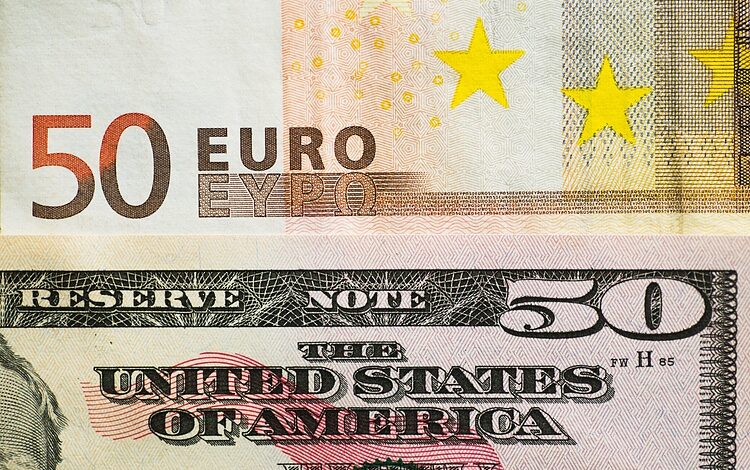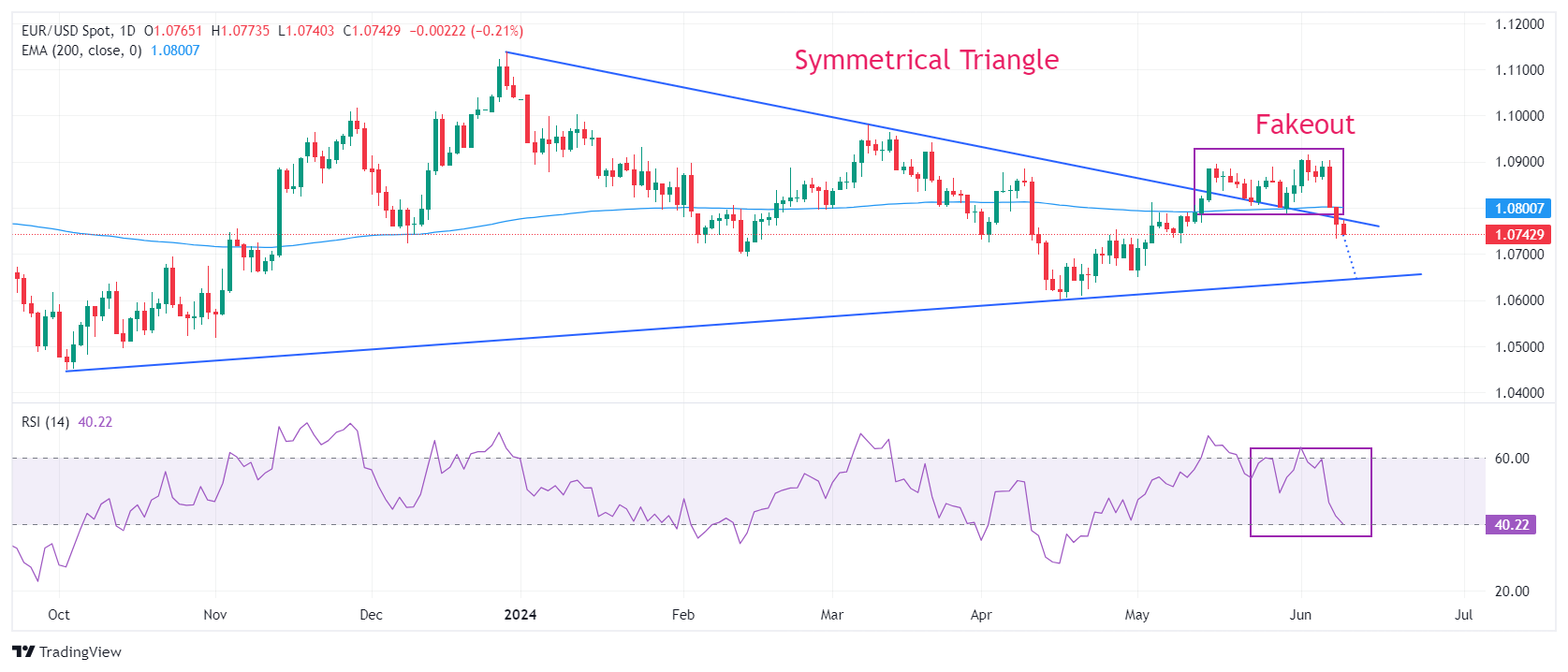EUR/USD slides further amid increasing uncertainty after EU election results

- EUR/USD stays on the back foot near 1.0730 as the European Union’s political uncertainty weakens the Euro’s appeal.
- The ECB refuses to commit to a specific interest-rate trajectory.
- The US Dollar’s appeal remains firm ahead of the Fed’s decision and the US CPI report.
EUR/USD shows weakness near the immediate support of 1.0730 in Tuesday’s European session. The major currency pair remains on the back foot as the Euro shifted into a bearish trajectory following French President Emmanuel Macron’s unprecedented decision to dissolve parliament and call for a snap election, which spooked political stability.
Macron’s decision to call for a snap election came after exit polls for EU parliamentary elections showed that seats won by Jordan Bardella-led-far-right National Rally came in at 32%-33%, more than twice the votes secured by Macron’s Centrist alliance.
European Central Bank (ECB) policymakers’ cautious approach to the interest rate outlook also fails to uplift the Euro. ECB policymakers worry that progress in inflation towards the bank’s target could stall as wage growth appears to be stubborn. On Monday, ECB President Christine Lagarde said in an interview that last week’s rate-cut move doesn’t commit to any linear declining path. “There might be periods where we hold rates again,” Lagarde said, according to Reuters.
Daily digest market movers: EUR/USD hit hard by multiple headwinds
- EUR/USD finds a temporary cushion after plunging to near 1.0730 as traders focus on the United States Consumer Price Index (CPI) data for May and the Federal Reserve’s (Fed) monetary policy decision on Wednesday.
- Annual core inflation, which strips off volatile food and energy prices, is estimated to have decelerated to 3.5% from April’s reading of 3.6%. In the same period, the headline inflation is expected to have grown steadily by 3.4%. While monthly headline inflation is forecasted to have grown at a slower pace of 0.1% from the former release of 0.3%, the core CPI is estimated to have maintained a steady growth rate of 0.3%. The US CPI report will indicate whether price pressures are on course to return to the desired rate of 2%.
- Meanwhile, the Fed is widely anticipated to keep interest rates steady in the range of 5.25%-5.50% for the seventh consecutive time. Therefore, investors will pay more attention to Fed Chair Jerome Powell’s press conference and the dot plot, which will indicate where policymakers see the federal fund rate heading. The CME FedWatch tool shows that 30-day Fed Fund Rate pricing data suggest only one rate-cut move this year, which could be announced either in the November or December meeting.
- Fed policymakers said they want to be sure about sustained progress in the disinflation process before considering rate cuts. They have already warned that premature rate cuts could revamp price pressures again. Increasing chances that the Fed will maintain the current interest rate framework for a longer period has improved the US Dollar’s appeal. The US Dollar Index (DXY), which tracks the Greenback’s value against six major currencies, holds gains above the crucial support of 105.00.
EUR/USD Price Today:
Euro PRICE Today
The table below shows the percentage change of Euro (EUR) against listed major currencies today. Euro was the strongest against the Australian Dollar.
| EUR | USD | GBP | JPY | CAD | AUD | NZD | CHF | |
|---|---|---|---|---|---|---|---|---|
| EUR | -0.20% | -0.32% | -0.15% | -0.09% | -0.03% | -0.19% | -0.17% | |
| USD | 0.20% | -0.12% | 0.05% | 0.10% | 0.14% | 0.00% | 0.01% | |
| GBP | 0.32% | 0.12% | 0.16% | 0.22% | 0.26% | 0.11% | 0.12% | |
| JPY | 0.15% | -0.05% | -0.16% | 0.05% | 0.08% | -0.07% | -0.05% | |
| CAD | 0.09% | -0.10% | -0.22% | -0.05% | 0.05% | -0.11% | -0.10% | |
| AUD | 0.03% | -0.14% | -0.26% | -0.08% | -0.05% | -0.15% | -0.15% | |
| NZD | 0.19% | 0.00% | -0.11% | 0.07% | 0.11% | 0.15% | 0.01% | |
| CHF | 0.17% | -0.01% | -0.12% | 0.05% | 0.10% | 0.15% | -0.01% |
The heat map shows percentage changes of major currencies against each other. The base currency is picked from the left column, while the quote currency is picked from the top row. For example, if you pick the Euro from the left column and move along the horizontal line to the US Dollar, the percentage change displayed in the box will represent EUR (base)/USD (quote).
Technical Analysis: EUR/USD continues its losing streak
EUR/USD extends its losing streak for the third trading session on Tuesday. The major currency pair weakened after failing to hold the breakout of the Symmetrical Triangle formation, suggesting that the overall trend has turned bearish. The shared currency pair has now returned inside the triangle formation and is expected to find support at 10.636, near the upward-sloping order of the chart pattern plotted from 3 October 2023 low at 1.0448.
The long-term outlook of the shared currency pair has also turned negative as prices dropped below the 200-day Exponential Moving Average (EMA), which trades around 1.0800.
The 14-period Relative Strength Index (RSI) falls sharply to 40.00. A decisive break below this level would trigger bearish momentum.
Euro FAQs
The Euro is the currency for the 20 European Union countries that belong to the Eurozone. It is the second most heavily traded currency in the world behind the US Dollar. In 2022, it accounted for 31% of all foreign exchange transactions, with an average daily turnover of over $2.2 trillion a day. EUR/USD is the most heavily traded currency pair in the world, accounting for an estimated 30% off all transactions, followed by EUR/JPY (4%), EUR/GBP (3%) and EUR/AUD (2%).
The European Central Bank (ECB) in Frankfurt, Germany, is the reserve bank for the Eurozone. The ECB sets interest rates and manages monetary policy. The ECB’s primary mandate is to maintain price stability, which means either controlling inflation or stimulating growth. Its primary tool is the raising or lowering of interest rates. Relatively high interest rates – or the expectation of higher rates – will usually benefit the Euro and vice versa. The ECB Governing Council makes monetary policy decisions at meetings held eight times a year. Decisions are made by heads of the Eurozone national banks and six permanent members, including the President of the ECB, Christine Lagarde.
Eurozone inflation data, measured by the Harmonized Index of Consumer Prices (HICP), is an important econometric for the Euro. If inflation rises more than expected, especially if above the ECB’s 2% target, it obliges the ECB to raise interest rates to bring it back under control. Relatively high interest rates compared to its counterparts will usually benefit the Euro, as it makes the region more attractive as a place for global investors to park their money.
Data releases gauge the health of the economy and can impact on the Euro. Indicators such as GDP, Manufacturing and Services PMIs, employment, and consumer sentiment surveys can all influence the direction of the single currency. A strong economy is good for the Euro. Not only does it attract more foreign investment but it may encourage the ECB to put up interest rates, which will directly strengthen the Euro. Otherwise, if economic data is weak, the Euro is likely to fall. Economic data for the four largest economies in the euro area (Germany, France, Italy and Spain) are especially significant, as they account for 75% of the Eurozone’s economy.
Another significant data release for the Euro is the Trade Balance. This indicator measures the difference between what a country earns from its exports and what it spends on imports over a given period. If a country produces highly sought after exports then its currency will gain in value purely from the extra demand created from foreign buyers seeking to purchase these goods. Therefore, a positive net Trade Balance strengthens a currency and vice versa for a negative balance.
Information on these pages contains forward-looking statements that involve risks and uncertainties. Markets and instruments profiled on this page are for informational purposes only and should not in any way come across as a recommendation to buy or sell in these assets. You should do your own thorough research before making any investment decisions. FXStreet does not in any way guarantee that this information is free from mistakes, errors, or material misstatements. It also does not guarantee that this information is of a timely nature. Investing in Open Markets involves a great deal of risk, including the loss of all or a portion of your investment, as well as emotional distress. All risks, losses and costs associated with investing, including total loss of principal, are your responsibility. The views and opinions expressed in this article are those of the authors and do not necessarily reflect the official policy or position of FXStreet nor its advertisers. The author will not be held responsible for information that is found at the end of links posted on this page.
If not otherwise explicitly mentioned in the body of the article, at the time of writing, the author has no position in any stock mentioned in this article and no business relationship with any company mentioned. The author has not received compensation for writing this article, other than from FXStreet.
FXStreet and the author do not provide personalized recommendations. The author makes no representations as to the accuracy, completeness, or suitability of this information. FXStreet and the author will not be liable for any errors, omissions or any losses, injuries or damages arising from this information and its display or use. Errors and omissions excepted.
The author and FXStreet are not registered investment advisors and nothing in this article is intended to be investment advice.
Editors’ Picks
GBP/USD keeps range above 1.2700 after UK jobs data
GBP/USD retreats from session highs but manages to hold above 1.2700 in the European session on Tuesday. The data from the UK showed the Employment Change in the three months to April was -140,000, making it hard for Pound Sterling to gather strength.
Is Ethereum price forming a local top?
Ethereum price faces struggles to surpass the $4,000 barrier. On-chain data reveals that investors appear to be capitalizing on gains, contributing to the emergence of a potential local peak.





